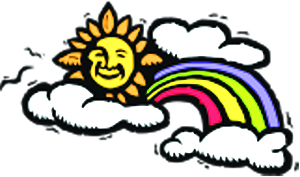
Upon stepping foot on the Moon, Buzz remarked to Houston, “Beautiful, beautiful. Magnificent desolation.”
~ Buzz Aldrin, July, 20, 1969
Lunar Module pilot on Apollo 11 and 2nd astronaut to step
foot on the moon
By Sue KILPATRICK
Long before our historical landing on the moon, we gazed upon it in wonder and awe. Its beauty on a clear night is evident, but insignificant compared to the scientific impact to life on earth.
Early man depended on the phases of the moon to chart the seasons and days. For thousands of years farmers, sailors and other sky-watchers have used the moon to predict weather. The next time you look up at the moon, consider this weather-related folklore, as stated in the Farmer’s Almanac:
– In the wane of the moon, a cloudy morning bodes a fair afternoon.
– If the crescent moon holds its points upward, able to hold water, it predicts a dry spell.
-If a new moon stands on its points, expect precipitation to fall out.
-Sailors agree that the full moon “eats clouds.”
-Two full moons in a month increase the chances of flood.
-A ring around the moon signifies bad weather coming.
-A pale full moon indicates rain, while a red one brings wind.
The Native Americans and other cultures gave distinctive names to all of the full moons occurring during the year. Each one represented important observations and happenings that impacted their lives. The many given to May include- Mother’s Moon, Milk Moon, Corn Planting Moon and Full Flower Moon. All mark a time of increasing fertility with the temperatures getting warmer and the chance of snow and frost over for the season. Conditions are contusive to safely bearing young and planting crops. Although we are no longer totally dependent on weather conditions for our livelihood, we still have our preferences.
Last night as I listened to the falling rain, I savored each moment knowing the raining season was coming to an end. This past week has brought us two late-season rainstorms. Both fronts were on the weak side, pretty typical for spring. Squeezing every drop into the rain gauge, we received around .75 inches, total. Northwest winds will blow any storm remnants out of area to be replaced by a short period warm temperatures. Come the weekend a deepening marine layer, low clouds and patchy fog will dominate once again. Meteorologist at the NWS are keeping an eye on a strong low pressure area (unusual for mid-May), off the Oregon coast and its possible effects(rain) this far south. Siding with climatology (what is normal this time of year), they are forecasting a warming trend next week. We’ll see? With the rain totals at 34.61and maybe still counting, the umbrella is not quite ready for the closet. An even 35 inches would look good in the records, as the final total for the season. Its been a good show and I always welcome an encore!
Sue Kilpatrick is a Crescenta Valley resident and Official Skywarn Spotter for the National Weather Service. Reach her at
suelkilpatrick@gmail.com.
